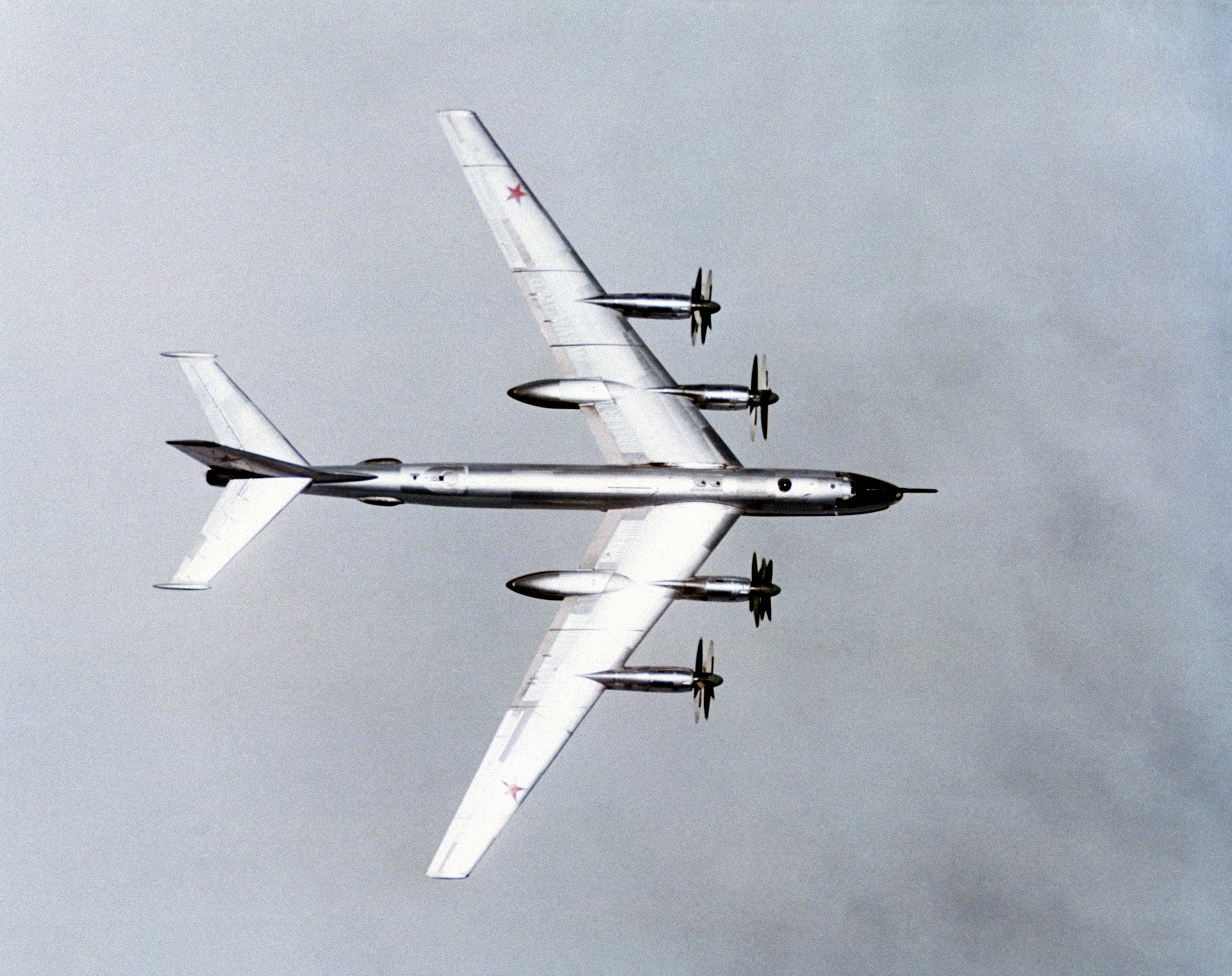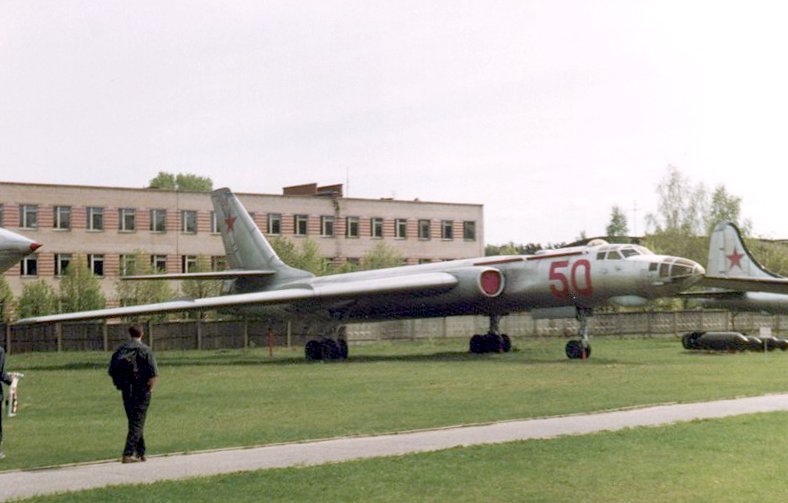|
326th Heavy Bomber Aviation Division
326th Tarnopolsky Order of Kutuzov Heavy Bomber Air Division (326 TBAD) is an Aviation Division of the Long Range Aviation of Russia. It was previously part of the 37th Air Army of the Supreme High Command. It was originally formed as the 326th Night Bomber Aviation Division, formed at Yegoryevsk in Moscow Oblast on 10 October 1943.Michael Holm326th Heavy Bomber Aviation Division accessed October 2011 On 23 June 1944, it was renamed the 326th Bomber Aviation Division. History In 1945, it had three regiments of Tupolev Tu-2 bombers. 12th Heavy Bomber Aviation Regiment was briefly part of the division in 1959–60 at Ostrov, Pskov Oblast, while flying Tu-16s. Components in 1990 according to Michael Holm: *Division Headquarters, Tartu **132nd Heavy Bomber Aviation Regiment (Raadi Airfield, Tartu, Estonian SSSR) with Tu-22M3 and Tu-16K **402nd Heavy Bomber Aviation Regiment (Balbasovo, Vitebsk Oblast) with Tu-22M3 and Tu-16K **840th Heavy Bomber Aviation Regiment (Soltsy-2, Novgorod ... [...More Info...] [...Related Items...] OR: [Wikipedia] [Google] [Baidu] |
Soviet Air Force
The Soviet Air Forces ( rus, Военно-воздушные силы, r=Voyenno-vozdushnyye sily, VVS; literally "Military Air Forces") were one of the air forces of the Soviet Union. The other was the Soviet Air Defence Forces. The Air Forces were formed from components of the Imperial Russian Air Service in 1917, and faced their greatest test during World War II. The groups were also involved in the Korean War, and dissolved along with the Soviet Union itself in 1991–92. Former Soviet Air Forces' assets were subsequently divided into several air forces of former Soviet republics, including the new Russian Air Force. "March of the Pilots" was its song. Origins The ''All-Russia Collegium for Direction of the Air Forces of the Old Army'' (translation is uncertain) was formed on 20 December 1917. This was a Bolshevik aerial headquarters initially led by Konstantin Akashev. Along with a general postwar military reorganisation, the collegium was reconstituted as the "Workers' an ... [...More Info...] [...Related Items...] OR: [Wikipedia] [Google] [Baidu] |
Tupolev Tu-2
The Tupolev Tu-2 (development names ANT-58 and 103; NATO reporting name Bat) was a twin-engine Soviet high-speed daylight and frontline (SDB and FB) bomber aircraft of World War II vintage. The Tu-2 was tailored to meet a requirement for a high-speed bomber or dive-bomber, with a large internal bombload, and speed similar to that of a single-seat fighter. Designed to challenge the German Junkers Ju 88, the Tu-2 proved comparable, and was produced in torpedo, interceptor, and reconnaissance versions. The Tu-2 was one of the outstanding combat aircraft of World War II and it played a key role in the Red Army's final offensives.Jackson 2003, p. 154. Design and development In 1937, Andrei Tupolev, along with many Soviet designers at the time, was arrested on trumped-up charges of activities against the State. Despite the actions of the Soviet government, he was considered important to the war effort and following his imprisonment, he was placed in charge of a team that was to design ... [...More Info...] [...Related Items...] OR: [Wikipedia] [Google] [Baidu] |
Tu-95K
The Tupolev Tu-95 (russian: Туполев Ту-95; NATO reporting name: "Bear") is a large, four-engine turboprop-powered strategic bomber and missile platform. First flown in 1952, the Tu-95 entered service with the Long-Range Aviation of the Soviet Air Forces in 1956 and was first used in combat in 2015. It is expected to serve the Russian Aerospace Forces until at least 2040. A development of the bomber for maritime patrol is designated the Tu-142, while a passenger airliner derivative was called the Tu-114. The aircraft has four Kuznetsov NK-12 engines with contra-rotating propellers. It is the only propeller-powered strategic bomber still in operational use today. The Tu-95 is one of the loudest military aircraft, particularly because the tips of the propeller blades move faster than the speed of sound. Its distinctive swept-back wings are set at an angle of 35°. The Tu-95 is the only propeller-driven aircraft with swept wings that has been built in large numbers. Desi ... [...More Info...] [...Related Items...] OR: [Wikipedia] [Google] [Baidu] |
30th Air Army
The 15th Air Army was a military formation of the Soviet Air Forces, active from July 1942 until December 1993. History It was formed between 11 July and 15 August 1942, in accordance with the directive of the commander of the Soviet Air Force of 10 July 1942, on the basis of the Air Force of the Bryansk Front. The formation of the army began in the village of Pavlovka (18 km southeast of the city of Yelets) in the Lipetsk Oblast. The 15th Air Army received its baptism of fire in the autumn of 1942, participating in the defensive battles near Voronezh and in the elimination of the enemy's foothold on the left bank of the Don. In the winter of 1943, it supported the front troops in the Voronezh–Kastornoye operation. In May 1943 it participated in an air operation to destroy German aircraft at airfields. In July-August 1943, as part of the Battle of Kursk, she participated in the Orlov Strategic Offensive, and in September 1943, it supported the front troops in the Bryans ... [...More Info...] [...Related Items...] OR: [Wikipedia] [Google] [Baidu] |
Chechen Republic Of Ichkeria
The Chechen Republic of Ichkeria (; ce, Нохчийн Республик Ичкери, Nóxçiyn Respublik Içkeri; russian: Чеченская Республика Ичкерия; abbreviated as "ChRI" or "CRI") was a ''de facto'' state that controlled most of the former Checheno-Ingush ASSR. On 30 November 1991, a referendum was held in Ingushetia in which the results dictated its separation from the Chechen Republic of Ichkeria, joining the Russian Federation instead as a constituent republic. The First Chechen War of 1994–96 resulted in the victory of the separatist forces. After achieving de facto independence from Russia in 1996, gangs arose over the country which the government put a large effort to crack down upon. In November 1997 Chechnya was proclaimed an Islamic republic. A Second Chechen War began in August 1999 and officially ended in April 2009 after several years of insurgency. In October 2022, Ukraine's parliament voted to recognize the Chechen Republic ... [...More Info...] [...Related Items...] OR: [Wikipedia] [Google] [Baidu] |
Dzhokhar Dudayev
Dzhokhar Musayevich Dudayev (, ; russian: Джохар Мусаевич Дудаев; ; 15 February 1944 – 21 April 1996) was a Soviet Air Force general and Chechen separatist leader who was the first president of the Chechen Republic of Ichkeria, a breakaway region in the North Caucasus, from 1991 until his assassination in 1996. Early life and military career Dudayev was born in Yalkhoroy from the Tsechoy teip in the Checheno-Ingush Autonomous Soviet Socialist Republic (ASSR), just a few days before the forced deportation of his family together with the entire Chechen population on the orders of Joseph Stalin. He was the thirteenth youngest child of veterinarian Musa and Rabiat Dudayev. He spent the first 13 years of his life in internal exile in the Kazakh Soviet Socialist Republic. His family was only able to return to Chechnya in 1957. Following the 1957 repatriation of the Chechens, he studied at evening school in Checheno-Ingushetia and qualified as an electrician. ... [...More Info...] [...Related Items...] OR: [Wikipedia] [Google] [Baidu] |
Amur Oblast
Amur Oblast ( rus, Аму́рская о́бласть, r=Amurskaya oblast, p=ɐˈmurskəjə ˈobləsʲtʲ) is a federal subject of Russia (an oblast), located on the banks of the Amur and Zeya Rivers in the Russian Far East. The administrative center of the oblast, the city of Blagoveshchensk, is one of the oldest settlements in the Russian Far East, founded in 1856. It is a traditional center of trade and gold mining. The territory is accessed by two railways: the Trans-Siberian Railway and the Baikal–Amur Mainline. As of the 2010 Census, the oblast's population was 830,103. Amur Krai () or Priamurye () were unofficial names for the Russian territories by the Amur River used in the late Russian Empire that approximately correspond to modern Amur Oblast. Geography Amur Oblast is located in the southeast of Russia, between Stanovoy Range in the north and the Amur River in the south, and borders with the Sakha Republic in the north, Khabarovsk Krai and the Jewish Auto ... [...More Info...] [...Related Items...] OR: [Wikipedia] [Google] [Baidu] |
Soltsy-2
Soltsy-2 (also spelled Sol'tsy, Soltsy, Solcy, Solcy 2) is an air base in Novgorod Oblast, Russia located 2 km north of Soltsy and 72 km southwest of Novgorod. It contains large aircraft revetments, with a separate compound of 9 hardened areas about 1 mile from the airfield. The base is home to the 40th Composite Aviation Regiment which flies the Tu-22M as part of the 22nd Guards Heavy Bomber Aviation Division. In 1992, the headquarters of the 326th Heavy Bomber Aviation Division (326 TBAD) arrived from Tartu Raadi Airfield in newly independent Estonia. In 1998 the division headquarters was moved to Ukrainka in the Far East. The 840th Heavy Bomber Aviation Regiment (840 TBAP) flew Tupolev Tu-22M aircraft from November 1951 through to 2010. The regiment was disbanded in 2010 following the changes initiated by the Russian military reforms from 2008. Airfield is properly maintained for occasional training of Russian Air Force and to service governmental flights in N ... [...More Info...] [...Related Items...] OR: [Wikipedia] [Google] [Baidu] |
Balbasovo
Orsha Airport (previously named Balbasovo Airbase, given as Balbasava, Bolbasovo, Orsha Southwest, and Orsha) is a commercial airport in Belarus, located 11 km southwest of Orsha. It has a long runway, large tarmac area, a terminal building, 3 commercial remote stands, and 30 large revetments. A remote revetment area contains 5 bomber pads and probably 5 fighter pads. The airport is also home to the Orsha Aircraft Repair Plant (OARP). It was home to 402nd Heavy Bomber Aviation Regiment (402 TBAP) flying Tupolev Tu-22M3 (ASCC: Backfire) aircraft as recently as 1993. The 402 TBAP's division headquarters were 326 TBAD at Soltsy-2 Soltsy-2 (also spelled Sol'tsy, Soltsy, Solcy, Solcy 2) is an air base in Novgorod Oblast, Russia located 2 km north of Soltsy and 72 km southwest of Novgorod. It contains large aircraft revetments, with a separate compound of 9 harden .... Its IATA code TXC was assigned in late 2021, in preparation of taking up commercial air transpo ... [...More Info...] [...Related Items...] OR: [Wikipedia] [Google] [Baidu] |
Tu-16
The Tupolev Tu-16 (NATO reporting name: Badger) is a twin-engined jet strategic heavy bomber used by the Soviet Union. It has been flown for almost 70 years, and the Chinese license-built Xian H-6 remains in service with the People's Liberation Army Air Force. Development In the late 1940s, the Soviet Union was strongly committed to matching the United States in strategic bombing capability. The Soviets' only long-range bomber at the time was Tupolev's Tu-4 'Bull', a reverse-engineered copy of the American B-29 Superfortress. The development of the notably powerful Mikulin AM-3 turbojet led to the possibility of a large, jet-powered bomber. The Tupolev design bureau began work on the Tu-88 ("Aircraft N") prototypes in 1950. The Tu-88 first flew on 27 April 1952. After winning a competition against the Ilyushin Il-46, it was approved for production in December 1952. The first production bombers entered service with Frontal Aviation in 1954, receiving the service designation ... [...More Info...] [...Related Items...] OR: [Wikipedia] [Google] [Baidu] |
Raadi Airfield
Raadi Airfield (Tartu Air Base) is a former air base in Estonia located northeast of Tartu. The land once belonged to Raadi Manor and is now designated as the new site of the Estonian National Museum. History In 1940 were requisitioned from the Raadi Manor estates to create a Russian airport.History ERM.ee, retrieved 31 December 2013 The airfield was fought over during the and the manor house was burnt during the Tartu Offensive. The airport became a major Soviet bomber base for fifty years. The secrecy of the airfield meant that foreigners were not allowed to visit the city. Dozens of bombers were ... [...More Info...] [...Related Items...] OR: [Wikipedia] [Google] [Baidu] |




